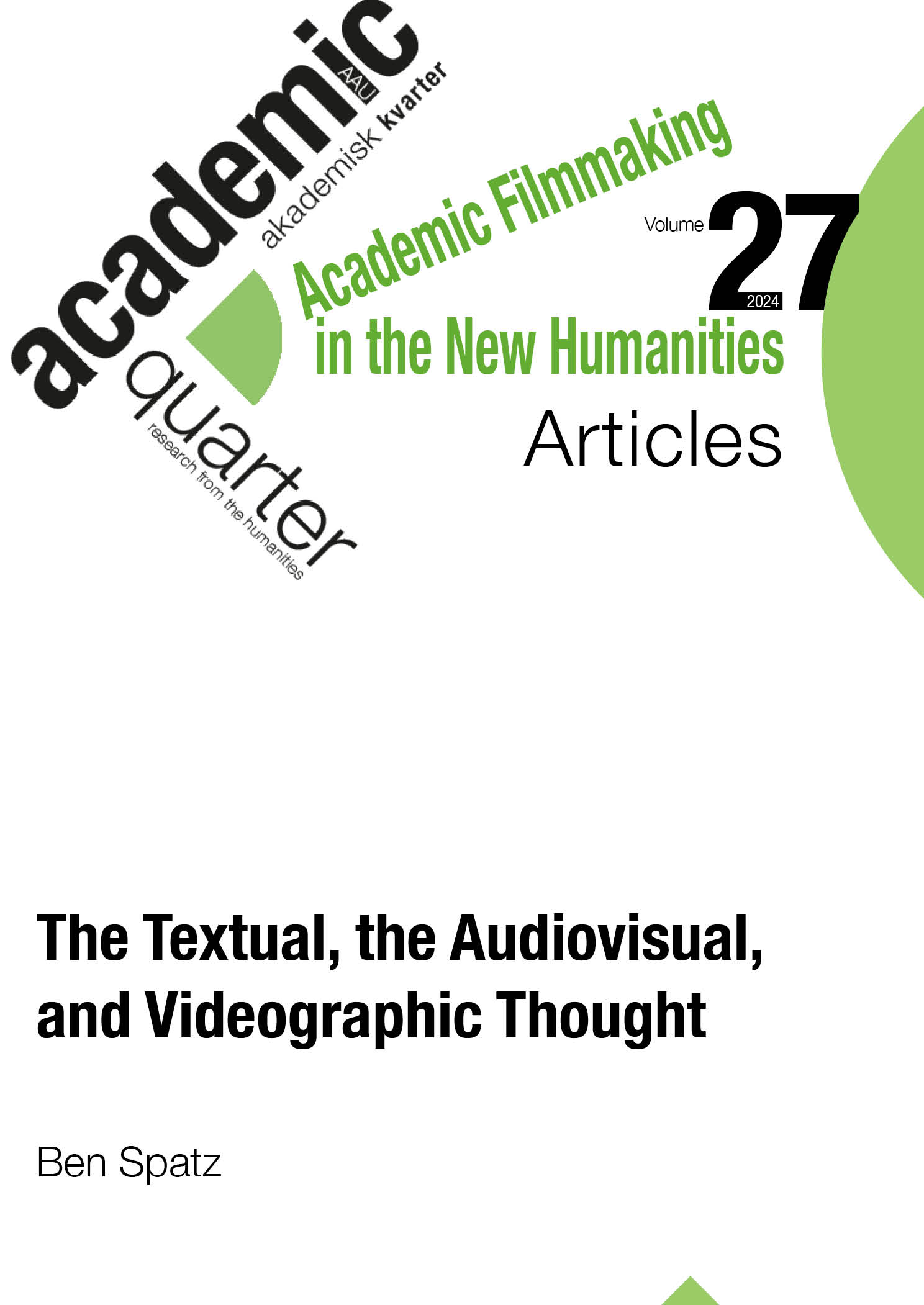Abstract | Abstract
This essay draws on the author’s experience as founding editor of the videographic Journal of Embodied Research (JER), as well as their own artistic research practice and critical theories of embodiment and identity, to examine shifting relationships among the textual, the audiovisual, and the videographic. Addressing each term in sequence, the essay builds on the idea of embodied research, and the experience of developing a style guide for JER, to rethink the textual and the audiovisual in the context of the videographic. As the space of videographic thought becomes ever more fluid and all-encompassing, it is incumbent upon filmmakers of all kinds to critically reexamine the ways in which video remains entangled with bodies, places, and the still-powerful technology of the written word. To support such a reexamination, approaches to academic filmmaking and the video essay should be put in conversation with practices of embodied research.
Referencer
Ahmed, Sara. 2007. Queer Phenomenology: Orientations, Objects, Others. Durham: Duke University Press. https://doi.org/10.1515/9780822388074
Bradley, Rizvana. 2023. Anteaesthetics: Black Aesthesis and the Critique of Form. Stanford, California: Stanford University Press. https://doi.org/10.1515/9781503637146
Brander Rasmussen, Birgit. 2012. Queequeg’s Coffin: Indigenous Literacies & Early American Literature. Durham: Duke University Press. https://doi.org/10.1215/9780822393832
Ferreira da Silva, Denise. 2007. Toward a Global Idea of Race. Borderlines 27. Minneapolis: University of Minnesota Press.
Jobson, Ryan Cecil. 2020. “The Case for Letting Anthropology Burn: Sociocultural Anthropology in 2019.” American Anthropologist 122 (2): 259–71. https://doi.org/10.1111/aman.13398
Journal of Embodied Research. 2022. “Glossary and Style Guide.” Accessed 1 May 2024. https://jer.openlibhums.org/site/styleguide/
Keathley, Christian, Jason Mittell, and Catherine Grant. 2019. “The Videographic Essay: Practice and Pedagogy.” Scalar. 2019. http://videographicessay.org/
McKittrick, Katherine. 2021. Dear Science and Other Stories. Errantries. Durham: Duke University Press. https://doi.org/10.1215/9781478012573
Mirzoeff, Nicholas. 2017. The Appearance of Black Lives Matter. Miami: Name Publications.
Reason, Matthew. 2006. Documentation, Disappearance and the Representation of Live Performance. Basingstoke; New York: Palgrave Macmillan. https://link.springer.com/book/10.1057/9780230598560
Sant, Toni, ed. 2017. Documenting Performance: The Context and Processes of Digital Curation and Archiving. London; New York: Bloomsbury Methuen Drama. https://doi.org/10.5040/9781472588210.ch-001
Spatz, Ben. 2017. “Embodiment as First Affordance: Tinkering, Tuning, Tracking.” Performance Philosophy 2 (2): 257–71. https://doi.org/10.21476/PP.2017.2261
Spatz, Ben. 2018. “The Video Way of Thinking.” South African Theatre Journal 31 (1): 146–54. https://doi.org/10.1080/10137548.2017.1414629
Spatz, Ben. 2021a. “Illuminations.” Journal of Embodied Research 4 (2). (9:20). https://doi.org/10.16995/jer.90
Spatz, Ben. 2021b. “Artistic Research and the Queer Prophetic.” Text and Performance Quarterly 46 (1-2): 81-105. https://doi.org/10.1080/10462937.2021.1908585
Spatz, Ben. 2024. Race and the Forms of Knowledge: Technique, Identity, and Place in Artistic Research. Evanston, Illinois: Northwestern University Press.
Spatz, Ben, Nazlıhan Eda Erçin, Ilona Krawczyk, and Agnieszka Mendel. 2022. “Whiteness.” Performance Philosophy 7 (2): 169–72. https://doi.org/10.21476/PP.2022.72349

Dette værk er under følgende licens Creative Commons Navngivelse – Ikke-kommerciel – Ingen Bearbejdede Værker (by-nc-nd).
Copyright (c) 2024 Ben Spatz
